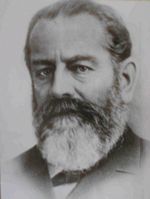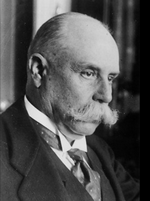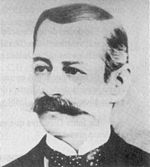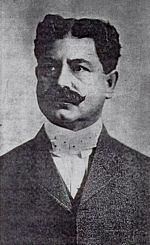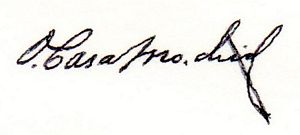Signatories on Banco Minero notes
The earlier ABNC notes were signed by Inocente Ochoa or Luis Terrazas as President, Enrique Creel or his brother Juan as Manager (Gerente), the younger Luis Terrazas, Juan Terrazas, Manuel Prieto or Martín Falomir as Boardmember (Consejero), and M. G. Granados, Ramón Cuellar or J. M. Aguirre Hernández as Interventor.
The later ABNC notes were signed by Juan A. Creel as Manager (Gerente), Luis Terrazas or Martín Falomir as President (Presidente) and Ramón Cuellar, Octavio Casa Madrid or A. Martínez as Interventor.
Presidente
|
Inocente Ochoa was a member of a wealthy family based in El Paso del Norte (later Ciudad Juárez) and had offered his hospitality to Benito Juárez when the latter took refuge there in 1864 and 1865. He was married to Concepción Samaniego, Mariano’s sister, and the two men co-operated in politics and business. He remained connected with the bank and was a director in 1897 and 1900. Ochoa was president from [ ] until [ ] and signed notes dated from 1888 to 1909, |
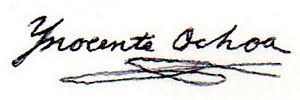 |
|
In 1868 Terrazas was re-elected governor. In July 1872 Juárez died and was succeeded as president by Sebastian Lerdo de Tejada. In 1876, when Lerdo announced that he was to seek re-election, the disappointed Porfirio Díaz again rose in revolt. Díaz defeated the Lerdistas and took Mexico City and from then until 1910 (except for the short period 1880-1884 when Manuel González was president) he held the presidency. Since Terrazas had opposed Díaz (and his supporter in Chihuahua, Angel Trias) the president maintained anti-Terracista administrations in the state through the 1880s and 1890s (though Terrrazas was governor from 1879 to 1884). However, by judicious investment and marriage, Terrazas built up an empire of cattle ranches, mills, banks and factories worth 27 million pesos. Díaz allowed Terrazas to become state governor again in 1903 and he was succeeded by his son-in-law Enrique Creel in 1907. Political hegemony now complemented economic power, as the Creel-Terrazas oligarchy came to dominate state politics, local government and the courts. Terrazas’ power was thus derived from his interests in land, his other commercial interests (he owned textile mills, granaries, railroads, telephone companies, candle factories, sugar mills, meat packing plants and several mines), and his position at the summit of the Chihuahuan oligarchy. With the Revolution Terraza lived in El Paso, Texas until 1919, when after losing his wife and suffering a stroke, he joined Creel and the rest of the clan in Los Angeles. He signed notes dated from 1910 to 1914. |
 |
| Martín Falomir, the consejero (see below), signed some $20 notes dated 5 December 1911/1912 as Presidente. | 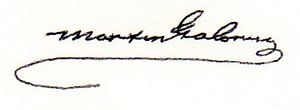 |
Gerente
|
Creel began his banking activities in 1881 as manager of the branch of the Banco Minero in El Paso del Norte (now Ciudad Juárez) and ended up as President of the bank. Through his family connections, vast personal wealth and astute business sense Creel was a prominent member of the oligarchy that came to dominate Chihuahuan industry, politics and the courts. He was elected regidor of Chihuahua in 1878. He was a deputy in several legislatures and at times represented Chihuahua and Durango. On 18 August 1904 Creel was named interim governor of Chihuahua and so resigned his posts, though the board reserved the right to accept his resignationAGN, Antiguos Bancos de Emisión, Actas de Banco Minero, libro 2, 27 February 1897 to 18 March 1905. He substituted for his uncle, Luis Terrazas, as governor from August 1904 to December 1906, when he went to Washington as Mexican ambassador. He was state governor from October 1907 until 1911 and at times also minister of foreign relations. He was president of the Comisión de Cambios that planned the monetary reforms of 1905. Creel was an organiser of or investor in many banks, including, as well as the Banco Minero, Banco Comercial Refaccionario and Caja de Ahorros de la República Mexicana in Chihuahua, the Banco de Durango, Banco Central Mexicano, Banco Mercantil de Monterrey, Banco de Guanajuato, Banco Hipotecario de Crédito Territorial Mexicano , Guarantee Trust and Banking Co. of El Paso, Texas, Banco Refaccionario de La Laguna and Banco de Michoacán. In his private activities he was president of the Asociación de Banqueros de la Republica Mexicana and on the board of the Batopilas Mining Company. In 1887 he was the first president of the Chihuahua Chamber of Commerce. Creel never fully won the trust of his nationalistic Mexican compatriots. As his critic Bulnes put it, Creel was ‘half yankee by blood’ and ‘by character and education a yankee-and-a-half’. He died on 17 August 1931 in Mexico City. He signed notes as Gerente dated from 1888 to 1905. |
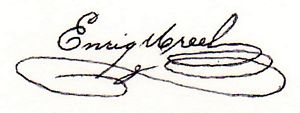 |
|
Juan Andrew Creel was born in Chihuahua on 29 November 1865, the brother of Enrique Creel. He was cajero in 1888 and appointed sub-gerente on 18 August 1904. On 18 March 1905 he took over the manager’s position from his brother and held it until the bank went into liquidation in the early 1930s. He signed notes dated from 1906 to 1914. He died in Mexico City on 11 August 1952. |
 |
Consejero
|
Manuel Prieto y Parra was born in Chihuahua on 12 November 1855. Prieto was a state deputy and represented Jalisco in both the Congress and the Senate. By profession he was a solicitor and magistrate of the Supremo Tribunal de Justicia. He was a member of La Universal, a law practice that had a virtual monopoly in Chihuahua, and lawyer for the Banco Minero and several important foreign companies and individuals. He was a partner with Luis Terrazas in a cotton-mill and a starch factory. In 1912 he contributed 5,000 pesos to help Orozco's rebellion and was president of the junta encharged with organising a loan of 1,200,000 pesos. He died in Chihuahua on 8 August 1937. He signed some $20 notes dated 1910 and 1911. |
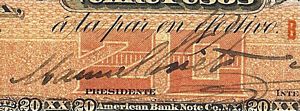 |
|
Luis Terrazas hijo was he son of General Terrazas (see above), born in 1861. He appears as a member of the board between 1896 and 1911 and his signature was printed in facsimile on some 1912 and 1913 $20 and $50 notes. Luis stayed in Chihuahua in late 1913 when the other directors decamped the United States and was badly treated by Villa. |
 |
|
As well as the Banco Minero he was a partner in the Banco Comercial Refaccionario de Chihuahua, the Caja de Ahorros de la República Mexicana, the Guarantee Trust and Banking Co. of El Paso and the Banco Refaccionario de La Laguna. He had investments in a transport company on the Balsas River, in the Industrial Jabonera de La Laguna, together with his brother-in-law Enrique C. Creel in a project to transport and distribute frozen meat, canned preserves and sausage meat from Chihuahua to Mexico City and intermediate points on the Ferrocarril Central, in real estate speculation in El Paso, Chihuahua and Camargo and in a steam-powered wheat flour mill in Nuevo Casas Grandes, among other activities. When in early 1896 Juan Terrazas made a trip to the United States in search of machinery and information about the breweries operating in the east of that country, preparations began for the investment to create the Compañía Cervecera de Chihuahua, S.A. This company was concessioned to Juan Terrazas, Enrique C. Creel and partners in May 1897, with tax exemption for ten years that in December of the following year was extended to twenty. He married María Luján, daughter of Ramón Remigio Luján and Francisca Zuloaga. He died in El Paso on 8 December 1925. He signed 2,000 $50 notes as consejero in 1910. |
 |
|
Falomir signed some $100 notes dated 1913 and the later $20 ABNC notes dated 3 July through to 25 July 1914 though Luis Terrazas was signing other denominations with dates in the same month. This suggests that Falomir merely stepped in as a substitute when Terrazas was absent. As Falomir signed the Bouligny and Schmidt notes he may have been in charge of operations in Mexico City. He fled Chihuahua when Villa reached the capital, and retired to Tucson. After the revolution he worked in the banking and exchange department of the International Exchange and Commission Company of El Paso. He died in Chihuahua in 1954. |
 |
| Luis Terrazas (see above) signed some $20 notes dated 1914 as Consejero. |
Interventor

